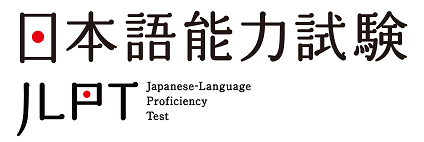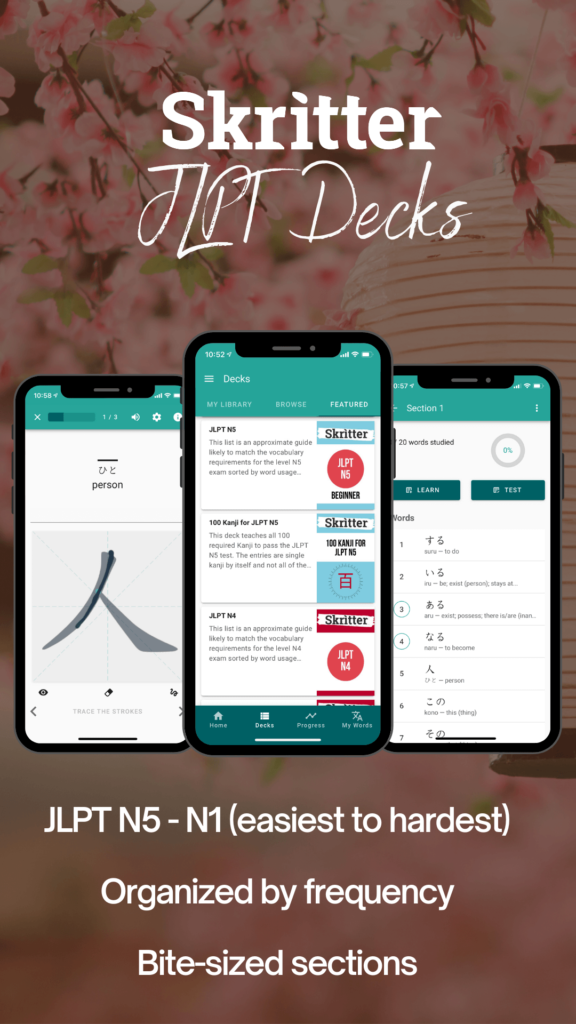
The JLPT (Japanese Language Proficiency Test) is a series of exams for non native Japanese speakers to measure your Japanese ability. Some jobs in Japan require that you pass a certain level to qualify for the job– there are 5 levels: N5 (the easiest) up to N1 (the hardest). In Japanese, it’s called the 日本語能力試験, or “Nihongo Nouryoku Shiken” translating to “Japanese language ability exam”.
Up until 2009 there was a set list of words for each level that you could refer to, however now there isn’t a set list, and the exam taker won’t know exactly what will be on their test. You can make approximations though to have a general idea of what will be on the test. There are three categories on the test: vocabulary / grammar, listening, and reading.
There used to be just 4 levels of the JLPT, however after 2009 an additional level (N5) was added. It’s held twice a year in Japan, and you can also take the JLPT in 40 other countries. It’s said that N2 is the minimum level you would want to pass if you will be using Japanese in your job, however some companies do require passing the N1.
This isn’t to say that you can’t get a job at certain companies unless you have a JLPT certificate, however it looks great on your resume, and again, some jobs do require that you’ve passed the JLPT up to a certain level.
Looking to take the JLPT (and most importantly pass it)? Fear not, we have you covered. Skritter’s JLPT decks cover our best approximation of what will be covered on each test and are in order by word frequency, so you can start learning the most commonly used words first. We also have separate decks for the Kanji that’s required for each test (for those who are just looking to study the single kanji).
| N1 | Advanced Level: The ability to understand Japanese used in a variety of circumstances. Reading One is able to read writings with logical complexity and/or abstract writings on a variety of topics, such as newspaper editorials and critiques, and comprehend both their structures and contents. One is also able to read written materials with profound contents on various topics and follow their narratives as well as understand the intent of the writers comprehensively. Listening One is able to comprehend orally presented materials such as coherent conversations, news reports, and lectures, spoken at natural speed in a broad variety of settings, and is able to follow their ideas and comprehend their contents comprehensively. One is also able to understand the details of the presented materials such as the relationships among the people involved, the logical structures, and the essential points. |
| N2 | Pre-Advanced Level: The ability to understand Japanese used in everyday situations, and in a variety of circumstances to a certain degree. Reading One is able to read materials written clearly on a variety of topics, such as articles and commentaries in newspapers and magazines as well as simple critiques, and comprehend their contents. One is also able to read written materials on general topics and follow their narratives as well as understand the intent of the writers. Listening One is able to comprehend orally presented materials such as coherent conversations and news reports, spoken at nearly natural speed in everyday situations as well as in a variety of settings, and is able to follow their ideas and comprehend their contents. One is also able to understand the relationships among the people involved and the essential points of the presented materials. |
| N3 | Intermediate Level: The ability to understand Japanese used in everyday situations to a certain degree. Reading One is able to read and understand written materials with specific contents concerning everyday topics. One is also able to grasp summary information such as newspaper headlines. In addition, one is also able to read slightly difficult writings encountered in everyday situations and understand the main points of the content if some alternative phrases are available to aid one’s understanding. Listening One is able to listen and comprehend coherent conversations in everyday situations, spoken at near-natural speed, and is generally able to follow their contents as well as grasp the relationships among the people involved. |
| N4 | Elementary Level: The ability to understand basic Japanese. Reading One is able to read and understand passages on familiar daily topics written in basic vocabulary and kanji. Listening One is able to listen and comprehend conversations encountered in daily life and generally follow their contents, provided that they are spoken slowly. |
| N5 | Basic Level: The ability to understand some basic Japanese. Reading One is able to read and understand typical expressions and sentences written in hiragana, katakana, and basic kanji. Listening One is able to listen and comprehend conversations about topics regularly encountered in daily life and classroom situations, and is able to pick up necessary information from short conversations spoken slowly. |
Click the links below to study the decks on Skritter!
JLPT Vocabulary Decks
JLPT N5
JLPT N4
JLPT N3
JLPT N2
JLPT N1
JLPT Single Kanji Decks
Kanji for JLPT N5
Kanji for JLPT N4
Kanji for JLPT N3
Kanji for JLPT N2
Kanji for JLPT N1
Learn Japanese with Skritter!




